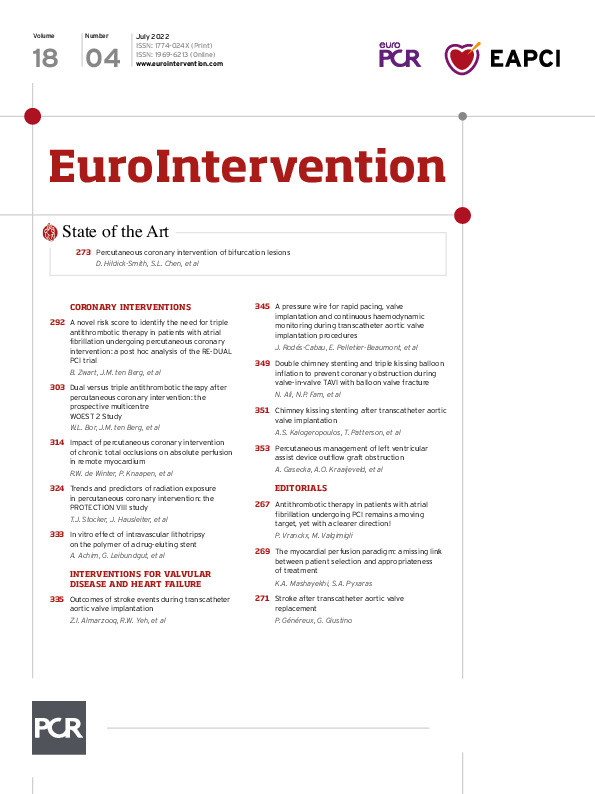Transcatheter aortic valve replacement (TAVR) has been established as a treatment option for patients with severe aortic stenosis (AS) across the spectrum of surgical risk1234. Since its inception, the rates of in-hospital stroke post-TAVR have declined substantially to a rate of ~2% with current devices1234. Most recently, in the PARTNER 3 trial, TAVR with the SAPIEN 3 balloon-expandable valve (Edwards Lifesciences) has been shown to be associated with a lower risk of stroke at 30 days, compared with surgical aortic valve replacement, among low-risk patients3. However, stroke remains a feared and potentially devastating complication. With the expansion of TAVR to lower-risk patients with longer life expectancy, understanding the long-term clinical and public health consequences of TAVR-related cerebrovascular events will become even more important.
In the present study by Almarzooq et al published in this issue of EuroIntervention5, the authors sought to investigate the incidence of periprocedural stroke after TAVR and its association with patient-oriented endpoints and healthcare expenditure using a large USA-based inpatient and outpatient administrative database of Medicare beneficiaries. The Medicare Institutional Outpatient Database includes information on 100% of claims from outpatient facility charges for Medicare fee-for-service beneficiaries, including outpatient expenditures and observation unit or emergency department visits. A total of 129,628 Medicare beneficiaries treated with TAVR between January 2012 and December 2017 were included. Of these, 5,549 (4.3%) had an ischaemic stroke during the index hospitalisation. The mean age of the study cohort was 82.6 years, 47.3% were women, and 94% were white. Transfemoral access was used in 94.2% of cases. Patients who experienced a TAVR-related stroke had a longer in-hospital stay and were more likely to be discharged to a skilled nursing facility (SNF) and inpatient rehabilitation facility. At 1 year, patients who had a TAVR-related stroke had a higher risk of the composite of death, myocardial infarction, or recurrent stroke, largely driven by an increased risk of recurrent stroke. Also, patients who experienced a TAVR-related stroke had higher expenditure ($79,373 versus $70,411; p<0.001) due to higher costs during the index hospitalisation, rehospitalisations, and at the skilled nursing facilities and inpatient rehabilitation facilities at 1 year. Finally, patients with a TAVR-related stroke had fewer mean days at home within the first year after the procedure.
The strengths of this study are the inclusion of a large, representative sample of patients treated in the USA and the assessment of important patient-oriented and healthcare economic outcomes. However, several limitations need to be addressed. First, the study only included Medicare beneficiaries, which limits the generalisability of these findings to younger patients. Second, the study sample included patients treated almost a decade ago. The substantial iterations in the transcatheter valve design, delivery system and procedural techniques are likely to be associated with a lower risk of TAVR-related strokes in the more recent years. In fact, the reported rates of post-TAVR stroke in this study (~4%) are higher than the current reported rates of ~2%6. The authors do not provide details on the use of cerebral embolic protection devices, nor the type of transcatheter valves implanted. Fourth, not all strokes post-TAVR are equal, and no details are provided on the severity (e.g., National Institutes of Health Stroke Scale [NIHSS]), imaging characteristics and residual disability after stroke. Therefore, it was not possible to characterise the impact of stroke severity on patient-oriented outcomes and healthcare expenditure.
The current study establishes post-TAVR stroke as an important contributor to the residual morbidity and mortality after TAVR. However, where do we stand in contemporary practice in terms of stroke prevention during TAVR? Currently, the rates of stroke are reported to be in the ~2% range with small variation across TAVR sites in the USA67. For example, in a report from the Society of Thoracic Surgeons-American College of Cardiology Transcatheter Valve Therapy Registry (STS/ACC TVT Registry), increasing site volume was associated with lower in-hospital risk-adjusted outcomes, including mortality, vascular complications, and bleeding, but was not associated with in-hospital stroke6. Embolic protection devices are increasingly being used in clinical practice in the USA and according to data from the STS/ACC-TVT Registry, up to 28% of sites and 13% of TAVR procedures are performed using embolic protection8. However, the efficacy and safety of embolic protection in reducing the risk of periprocedural stroke remains inconclusive910. Larger trials, such as the Stroke PROTECTion With SEntinel During Transcatheter Aortic Valve Replacement trial (PROTECTED TAVR; ClinicalTrials.gov: NCT04149535), will bring meaningful insight on whether routine cerebral protection during TAVR should be performed. Finally, antithrombotic therapies have failed to demonstrate a reduction in thromboembolic events post-TAVR10. In addition, risk models to accurately predict the risk of stroke post-TAVR are lacking and, therefore, preprocedural identification of patients who could derive a larger benefit from interventions that reduce the risk of cerebral embolism remains challenging.
With the expansion of TAVR to lower-risk patients and with further iterations of transcatheter devices, it is plausible that the reported incidence of stroke post-TAVR will continue to decline. The effectiveness of cerebral embolic protection during TAVR will need to be established in adequately powered randomised controlled trials. However, the cost-effectiveness of these devices will likely be influenced by the individual periprocedural stroke risk. That being said, even after factoring in the cost of this morbid complication (~$9,000 USD), we could agree that the cost-effectiveness of cerebral embolic protection devices is viable. Further research is needed to characterise the clinical and socioeconomic impact of stroke among younger, lower-risk patients undergoing TAVR and to develop effective and safe measures to predict this dreadful complication.
Conflict of interest statement
P. Généreux received personal fees from Abbott Vascular, Boston Scientific, Cardiovascular Solutions, Edwards Lifesciences, Medtronic, Cordis, Saranas, Pi-Cardia, and Sig.num. G. Giustino received consultation fees (advisory board) from Bristol-Myers Squibb/Pfizer.
Supplementary data
To read the full content of this article, please download the PDF.

